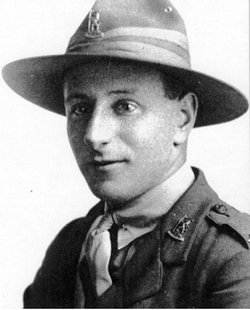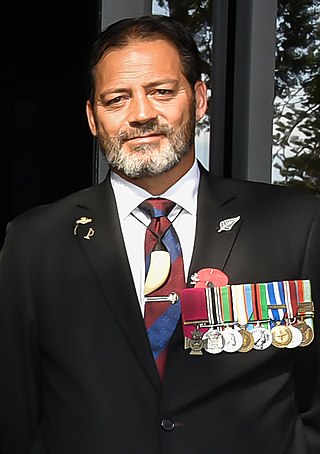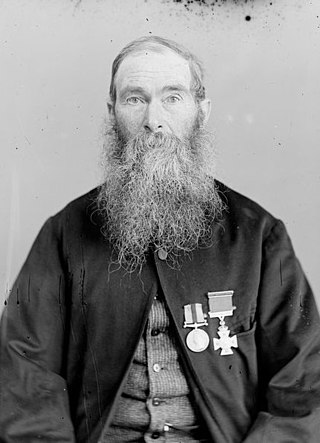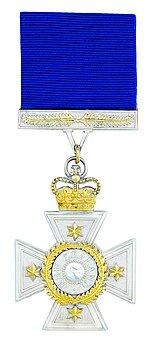
Nishan-e-Haider, is the highest military gallantry award of Pakistan. The Nishan-e-Haider is awarded posthumously and only to members of the Pakistan Armed Forces. It recognises the highest acts of extraordinary bravery in the face of the enemy in air, land, or sea. It has been awarded only 11 times since Pakistan's independence in 1947.
Stewart Graeme Guthrie, GC was a New Zealand Police sergeant and is the most recent Commonwealth civilian recipient of the George Cross, the highest award for conspicuous gallantry not in the face of an enemy awarded in certain Commonwealth countries. He received the award for his role in the police response to the Aramoana massacre, in which he lost his life.

Samuel Frickleton, was a soldier in the New Zealand Military Forces and a recipient of the Victoria Cross (VC), the highest award of the British Commonwealth for gallantry in the face of the enemy.

Harry John Laurent, VC was a New Zealand recipient of the Victoria Cross (VC), the highest award for gallantry in the face of the enemy that can be awarded to British and Commonwealth forces.

The Military Medal (MM) was a military decoration awarded to personnel of the British Army and other arms of the armed forces, and to personnel of other Commonwealth countries, below commissioned rank, for bravery in battle on land. The award was established in 1916, with retrospective application to 1914, and was awarded to other ranks for "acts of gallantry and devotion to duty under fire". The award was discontinued in 1993, when it was replaced by the Military Cross, which was extended to all ranks, while other Commonwealth nations instituted their own award systems in the post war period.

The Aramoana massacre was a mass shooting that occurred on 13 November 1990 in the small seaside township of Aramoana, northeast of Dunedin, New Zealand. Resident David Gray killed 13 people, including local police Sergeant Stewart Guthrie, one of the first responders to the reports of a shooting, after a verbal dispute between Gray and his next-door neighbour. After a careful house-to-house search the next day, police officers led by the Anti-Terrorist Squad located Gray, and shot and injured him as he came out of a house firing from the hip. He died in an ambulance while being transported to hospital.

Bill Henry "Willie" Apiata, VC is a former corporal in the New Zealand Special Air Service, who became the first recipient of the Victoria Cross for New Zealand. He received the award on 2 July 2007 for bravery under fire during the War in Afghanistan in 2004, in which he carried a gravely wounded comrade across a battlefield, under fire, to safety.

Sam was an army dog who served with the Royal Army Veterinary Corps Dog Unit. While serving in Bosnia and Herzegovina in the 1990s, Sam helped to apprehend an armed man and also to hold back an armed mob besieging a compound where Serbs were taking refuge. He received the Dickin Medal, the animals' equivalent of the Victoria Cross, in 2003 for these acts of bravery.
Gordon Love Bastian, was an engineering officer in the British Merchant Navy who was awarded the Albert Medal for risking his own life to save other members of the crew of SS Empire Bowman after it was torpedoed on 31 March 1943. In 1971, living recipients of the Albert Medal and Edward Medal were instructed to return their medal and were instead issued with the George Cross, the highest decoration for gallantry awarded to civilians or to military personnel for actions "not in the face of the enemy" in the United Kingdom and Commonwealth
Francis Joseph Mace was a Taranaki settler whose exploits during the Taranaki Wars earned him much praise. Chief among his awards was the New Zealand Cross, the highest colonial gallantry award available in New Zealand.

Leon Kristopher Smith, was a New Zealand Army soldier who was posthumously awarded the New Zealand Gallantry Decoration and the Charles Upham Bravery Award for his actions when attempting to resuscitate a mortally wounded colleague, while responding to an insurgent attack on the British Council Offices in Kabul, Afghanistan in 2011. Smith, who was a member of the New Zealand Special Air Service, was himself mortally wounded during a later operation in Afghanistan.

The Christchurch mosque shootings were two consecutive mass shootings on two mosques in Christchurch, New Zealand on 15 March 2019. They were committed by Brenton Tarrant who entered both mosques during Friday prayer, firstly at the Al Noor Mosque at 1:40 p.m. and later at the Linwood Islamic Centre at 1:52 p.m.
The 1991 New Zealand bravery awards were announced via a Special Honours List dated 19 December 1991. Twelve of the 33 recipients were recognised for acts of bravery during the Aramoana Massacre on 13 November 1990.
The 1974 New Zealand bravery awards were announced via a Special Honours List dated 29 March 1974, and recognised one person for an act of bravery the previous year.
The 1978 New Zealand bravery awards were announced via four Special Honours Lists dated 20 April, 18 May, 13 July, and 2 November 1978, and recognised six people for acts of bravery in 1977 or 1978.
The 1999 New Zealand bravery awards were announced via a special honours list on 23 October 1999. The awards recognised 30 people, including six posthumously, for acts of bravery between 1989 and 1998.
Randolph Gordon Ridling, was a New Zealand soldier who served during the First World War on the Western Front with the New Zealand Expeditionary Force. He was awarded the Albert Medal in 1919 for saving the life of a soldier during a grenade training exercise the previous year. After the war, he studied at the University of Cambridge and subsequently worked in the education sector in New Zealand. In 1971, the Albert Medal was disestablished by royal warrant as a gallantry award and living recipients were required to swap their medals for the George Cross. Ridling, for sentimental reasons, sought an exemption from Queen Elizabeth II to retain his medal, which was granted. He died in 1975, aged 86.

Samuel Austin was an Irishman who served with the British Army and the New Zealand colonial militia. He was a recipient of one of the world's rarest gallantry decorations, the New Zealand Cross.
The 2021 New Zealand bravery awards were announced via a Special Honours List on 16 December 2021. The awards recognised the bravery of 10 people in connection with the Christchurch mosque shootings on 15 March 2019.










